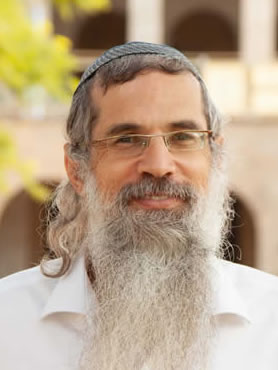The Parable of Shir Hashirim
By: Rav Avraham Rivlin
Shir Hashirim, on a superficial level, appears to be a love story about a shepherd and his beloved, making it one of the most problematic sefarim in terms of its inclusion in Tanach. Megillat Esther, for example, while not mentioning Hashem's Name explicitly, has a clear message, and there was no question about its inclusion in Tanach. The inclusion of Shir Hashirim in the Canon, however, was not so clear. [The Gemara in Shabbat has a similar discussion about the inclusion of Yechezkel and Kohelet, although there the issue was the apparent contradictions to the Torah that had to be explained.]
The Mishna in Masechet Yadayim has a dispute if Shir Hashirim defiles the hands, i.e., whether it is considered "kitvei hakodesh." (The Sages made this decree, because people would store Trumah with the kitvei hakodesh, thinking that both are holy, and mice would eat the scrolls. Therefore, they decreed that kitvei hakodesh would defile hands, thus invalidating the Trumah, so that people would no longer store the scrolls with the Trumah.) Some Tannaim maintained that kitvei kodesh do not include Shir Hashirim. One reason seems to be that it is merely King Shlomo's wisdom. Furthermore, since externally Shir Hashirim appears to only be a kind of love story, it is clear why it should not be included. R. Akiva, however, praises Shir Hashirim as "holy of holies," greater than all the songs in Tanach, such as Shirat Hayam and Shirat David. How are we to understand the position of R. Akiva? Furthermore, what does R. Akiva mean, "All the Ketuvim are holy, while Shir Hashirim is holy of holies?"
Rav Gershtenkoren (the first mayor of Bnei Brak), in "Ahava Beta'anugim," collected the various Kabbalistic interpretations of Shir Hashirim. Rav Untermann zt"l, in his haskama (approbation) to this sefer, explains that "holy" and "holy of holies" do not merely indicate degrees of spiritual value, but are defining terms, as we find in relation to sacrifices -- "kodoshim kalim" and "kodshei kodoshim." What is the difference? In kodoshim kalim, the owner also receives a portion, whereas in kodshei kodoshim the Israelite owner does not receive anything, but rather the sacrifice is primarily for Heaven. So too, here, R. Akiva is saying that while all the Scriptures have a deeper spiritual meaning, there also is significance to their simple meaning for Israel -- "ain mikra yotzei midei p'shuto" -- to which we add the levels of drash, remez and sod. Shir Hashirim, though, is not so. Am Yisrael, the "owner," has no portion in the pshat -- how a young girl chases her lover, and he runs away, etc. Thus, Shir Hashirim is a parable, and only so, while one who looks at the story and analyzes it at face value is completely missing the point of the sefer.
Rav Kook has an important introduction to Shir Hashirim, found in Olat Re'iya, vol. II (Prayers of Shabbat). He explains the statement of R. Akiva in the following way. Imagine a person standing on a tall tower with telescope, who identifies a star high above and exclaims, "What a distant star!" At the bottom of the tower stands a shortsighted midget, who hears this. He imagines that it must be 10 feet away, since this is the limit of his perception. Thus, one who does not have "ahava ila'ah" ("upper," i.e., spiritual love), and is limited to corporeal love, views Shir Hashirim also in this way. Only R. Akiva -- who was able to give up his life for the love of Hashem, and who stated that he waited his entire life for this opportunity -- is able to appreciate this love. [Bear in mind that R. Akiva is also the only Tanna about whom we find that he did have "love story" with his wife, and he was able to direct it to the One Above.]
What is this "ahava ilia'ah?" There are three levels of parable to understand Shir Hashirim:
A) Rambam, Ralbag, and others explain the story as a parable to the struggle between the body and soul of each individual. The body wants to stay in this world, while the soul wants to return to Hashem. Thus, the "girl" represents the soul, her "lover" is Hashem, and the "others," who prevent the soul from returning, represent the body. Indeed, five times King Shlomo meets with G-d, the final time at his death.
B) On a deeper level, most commentators, such as Rashi and the Ibn Ezra, explain based on the Midrash that Shir Hashirim describes the relationship between G-d and Knesset Yisrael. What is Knesset Yisrael? A collection of the souls of all Yisrael throughout all the generations. Thus, Shir Hashirim has references to the entire history of Klal Yisrael: the Exodus -- "lesusati berichvei Paro"; the building of the Mishkan -- "bein shadai yalin"; the sin of the golden calf -- "ad shehamelech bimsibo"; as well as events in the future. Sometimes Bnei Yisrael seek G-d, and sometimes they run away. G-d comes knocking for them, but until they come around, they miss the opportunity for geulah. Rashi writes in his introduction to Shir Hashirim:
Shlomo saw with Ruach Hakodesh that Israel is destined to be exiled ... and to remember the first love that they were a treasure among all the nations, saying, "Let me go and return to my first husband" ...
He wrote this book with Ruach Hakodesh in the metaphor of an abandoned women, who desires her husband ... and admits her rebellion. Her husband also shares in her troubles, and mentions the chesed of her youth, ... letting her know that she is still his wife, and he is her husband, and he is destined to return to her.
C) In the Kabbalistic works, the shepherd is Hashem, and his lover is the entire Creation -- every stone and twig. When G-d created the world, a certain distance was formed between Him and the world, in order for it to take a physical form. The Creation seeks to return to G-d -- to see that it is a part of Him, and that everything is G-dliness in various forms; it seeks to return to the state before Creation. Rav Kook zt"l writes along these lines about Teshuva, that the world returns to its earlier spiritual state. Similarly, the whole idea of "yemot hamashiach" (the Messianic era) is to return to the state of the world before the sin of Adam. The world will return to energy. [There is an allusion to this in Parshat Ki Tisa, where Moshe's face radiates. His soul became so dominant that his flesh began to disappear. Ramchal writes that this would also have happened to Adam had he not sinned. Everything would have turned into spirituality ("ohr" with an aleph), but instead it turned into skin ("or" with an ayin).]
There is an additional point that must be made about this parable, which we will introduce with a question about Pesach. It would seem that the whole story of Pesach begins with the Exodus from Egypt. Yet, Chazal teach that eight events in Sefer Bereishit occurred on 15 Nisan. For example, Lot baked matzot for the angels, and Rashi comments that it was Pesach. (In fact, almost every "night" in Bereishit is associated with this night of Pesach, as we find in the song, "Vayehi bachatzi halayla.") But there was no Exodus yet?!
The Beit Halevi writes that it is a mistake to think that Pesach occurs in Nisan because Bnei Yisrael happened to have left Egypt then. Rather, the idea of freedom at this time in the yearly cycle existed before the Creation, since the Torah preceded the world. We see in Nature, as well, that in the spring season the whole creation comes to life. Rather, because Nisan is the time of freedom -- that is why Bnei Yisrael left then! So too, the matzot -- simple bread -- also precedes the Exodus.
[We find a similar notion regarding the sun and moon. It seems that the obvious need for the sun is to provide light and warmth for the world. However, the Torah states, "They shall serve as signs, and as festivals, and for days and years; and they shall serve as luminaries ... to shine upon the earth." (Bereishit 1:14) Rashi comments, "additionally they shall serve as luminaries." The sun was created primarily for festivals, for kiddush hachodesh and ibur hashana, and, incidentally, the world receives light and warmth from it.]
In the same manner, we normally understand the relationship between man and woman as something natural, which should be elevated to the love of Hashem. But this perspective is backwards! Hashem created the world so that it should want to return to Him on these three levels -- the individual soul, Knesset Yisrael, and the Creation. To illustrate this, he instilled in people the love of man and women to serve as a parable to love of Him. Perhaps for this reason it is called "kodesh kodoshim," since it turns the most base aspect of man into something most holy.
Shiur ID: 3980
Do you have a comment or question on the shiur?
Comment below and we'll join the discussion
Add your comments:



.jpg)

.jpg)
.jpg)
